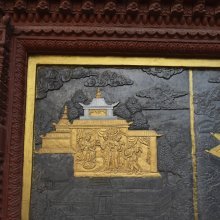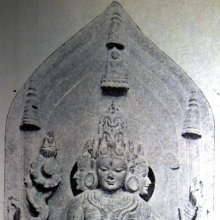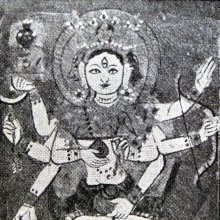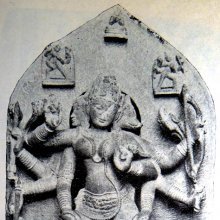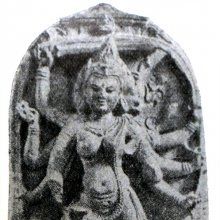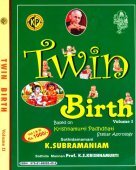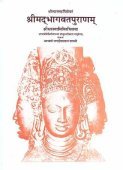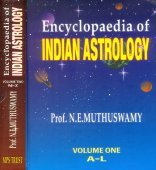Womb: 1 definition
Introduction:
Womb means something in Hinduism, Sanskrit. If you want to know the exact meaning, history, etymology or English translation of this term then check out the descriptions on this page. Add your comment or reference to a book if you want to contribute to this summary article.
Images (photo gallery)
(+4 more images available)
In Hinduism
Vastushastra (architecture)
Source: Shodhganga: Elements of Art and Architecture in the Trtiyakhanda of the Visnudharmottarapurana (vastu)The Womb (chamber) is another name for the Sanctuary (of a Temple) which is denoted by the Sanskrit term Garbhagṛha and refers to the “central hall” part of the Hindu Temple, according to the Viṣṇudharmottarapurāṇa, an ancient Sanskrit text which (being encyclopedic in nature) deals with a variety of cultural topics such as arts, architecture, music, grammar and astronomy.—According to the Viṣṇudharmottarapurāṇa, [the garbhagṛha] should be decorated with various figures and it should not be skull-shaped or pointed. That means the Viṣṇudharmottarapurāṇa recommends a separated room inside the main temple which can be considered as the Womb chamber of the temple.

Vastushastra (वास्तुशास्त्र, vāstuśāstra) refers to the ancient Indian science (shastra) of architecture (vastu), dealing with topics such architecture, sculpture, town-building, fort building and various other constructions. Vastu also deals with the philosophy of the architectural relation with the cosmic universe.
See also (Relevant definitions)
Query error!
Full-text (+1235): Garbha, Jarayuja, Garbhashaya, Garbhastha, Yoni, Yonija, Ayonija, Garbhavasa, Jarayu, Prasutivayu, Jathara, Yauna, Garbhika, Ulba, Kukshi, Spandana, Ulva, Audarya, Garbhasthana, Janmasthana.
Relevant text
Search found 365 books and stories containing Womb, The womb; (plurals include: Wombs, The wombs). You can also click to the full overview containing English textual excerpts. Below are direct links for the most relevant articles:
Yavanajataka by Sphujidhvaja [Sanskrit/English] (by Michael D Neely)
Verse 5.8 < [Chapter 5 - Rules of Impregnation]
Verse 5.12 < [Chapter 5 - Rules of Impregnation]
Verse 5.2 < [Chapter 5 - Rules of Impregnation]
Bhagavati-sutra (Viyaha-pannatti) (by K. C. Lalwani)
Part 3 - Harinaigameṣī (the order-bearer of Śakra) < [Chapter 4]
Part 3 - On the state of pregnancy < [Chapter 7]
Part 5 - On the migration of the embryo to infernal and other existences < [Chapter 7]
Chaitanya Bhagavata (by Bhumipati Dāsa)
Verse 2.1.199-201 < [Chapter 1 - The Beginning of the Lord’s Manifestation and His Instructions on Kṛṣṇa-saṅkīrtana]
Verse 2.14.42 < [Chapter 14 - Yamarāja’s Saṅkīrtana]
Verse 2.1.204 < [Chapter 1 - The Beginning of the Lord’s Manifestation and His Instructions on Kṛṣṇa-saṅkīrtana]
Chandogya Upanishad (english Translation) (by Swami Lokeswarananda)
Hevajra Tantra (analytical study) (by Seung Ho Nam)
1.3. Buddha Nature (tathagatagarbha) and the Cult of Deity Yoga < [Chapter 3 - Tantric Doctrine in Hevajra Tantra]
2.3. Internal Initiation < [Chapter 3 - Tantric Doctrine in Hevajra Tantra]
1.2. Wisdom (prajna) and Means (upaya) < [Chapter 3 - Tantric Doctrine in Hevajra Tantra]
Devi Bhagavata Purana (by Swami Vijñanananda)
Related products

